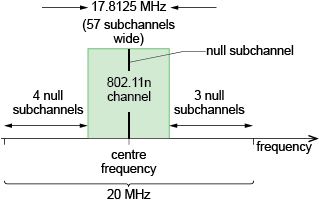4.7 WiFi maximum transmission rate
The 20 MHz channel width of common versions of WiFi is divided into 64 OFDM sub-channels, each 312.5 kHz wide. However, not all 64 subchannels are used. For example in 802.11n the three subcarriers at the lower end of the channel and four subcarriers at the upper end are nulled (see Figure 4.12).
This results in power being transmitted across a band approximately 17.8 MHz wide within the 20 MHz band. This is done because OFDM is noted for the high level of power that spills out on either side of the transmission band. Restricting transmission to a 17.8 MHz band ensures that most transmitted power stays within the 20 MHz channel.

The subcarrier on the central frequency is also nulled, which enables receivers to locate the centre of the transmission band and for other reasons related to the way subcarriers are modulated and demodulated.
The 8 nulled subchannels shown in Figure 4.12 leave 56 usable subchannels from the total of 64. Four of the 56 are used for control data, leaving 52 subchannels for user data. A symbol rate of 250 × 103 symbols per second per subchannel is standard across the common WiFi versions.
From this information the maximum transmission rate across all 52 subchannels of 802.11n to be calculated. The calculation is based on the use of the highest order of modulation, which is 64-QAM in 802.11n. This gives 6 bits per symbol. The number of bits per second across the 52 usable subchannels is:
The highest code rate for 802.11n is 5/6. That is, only 5 bits in 6 are ‘useful’ data, the sixth bit being redundancy for error control. Hence the maximum transmission rate is:
This is the figure given in Table 2.1. A rate of 600 Mbit s−1 is usually claimed for 802.11n. This is based on the use of 40 MHz of spectrum (slightly more than doubling the 65 Mbit s−1 calculated above) and four MIMO streams (quadrupling the transmission rate relative to a single stream).
